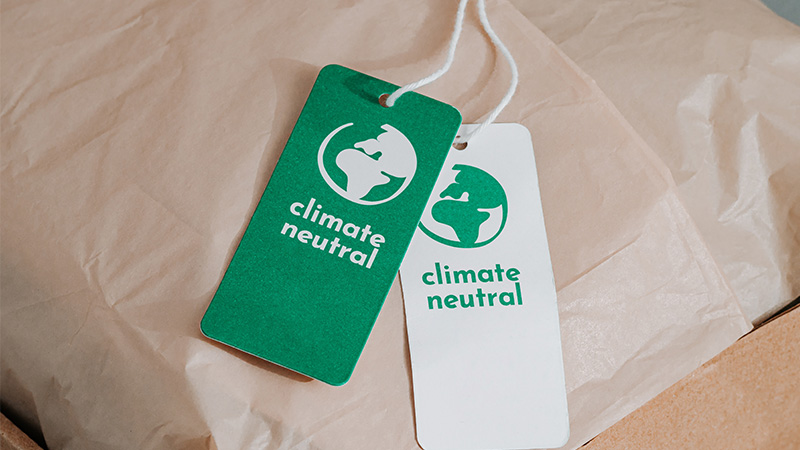Worldwide carbon emissions due to e-commerce logistics are predicted to hit 25 million CO2 metric tonnes1 by 2030. And with climate change being a huge global issue, e-commerce retailers are increasingly expected to ensure more sustainable practices. So, how do you reduce your business’s e-commerce carbon footprint? Here we look at what causes carbon emissions in e-commerce and offer some ideas on solutions to carbon emissions for e-commerce businesses.
What Causes Carbon Emissions in the E-commerce industry?
Here are six activities that increase the carbon footprint of the e-commerce industry.

1. Poor packaging
Sellers often ship products in standard-sized boxes, with lots of empty space filled with unnecessary material. As well as creating waste, the package takes up unnecessary space while being transported, increasing its carbon footprint. Then there is the issue of the materials used: with conventional packaging materials, such as bubble-wrap, the plastics used are energy-intensive to manufacture and can take decades or even centuries to break down.

2. Impulse purchases
E-commerce sites often encourage consumers to impulse buy, offering discounts and rewards. While clearly good for business, increased buying leads to increased production and more CO2 emissions.

3. Frequent customer returns
When returns are free and easy, many consumers buy multiple items, intending to return several of them. This, of course, increases carbon emissions from the additional transport involved when returning products.

4. Energy intensive devices
With e-commerce increasingly taking place on mobile phones, these devices need more computing power and stronger batteries. As a result, e-commerce has helped drive up energy consumption.

5. Vast data centers
E-commerce has also driven an increase in the amounts of data that needs to be processed, stored, and retrieved. This has resulted in enormous data centers that consume huge amounts of energy – as well as mirror servers in separate locations that add to the problem.

6. Fast transport methods
Even in these days of climate-consciousness, consumers still want to receive their purchases quickly. Especially in cross-border e-commerce, this often leads to the use of air transport, which has the largest carbon footprint of all transport options.
9 Ways Companies Can Reduce their Carbon Footprint
The good news is that there are plenty of ways to reduce your e-commerce carbon footprint. Here are nine to consider.

1. Track carbon emissions
The first step to reducing your e-commerce carbon footprint is tracking carbon emissions. They are divided into three different types2: Scope 1, Scope 2 and Scope 3. Scope 1 is your business’s direct emissions; Scope 2 covers indirect emissions from purchased energy (eg. electricity); and Scope 3 are emissions produced by other businesses in your supply chain. You’ll find guidance and calculation tools on the Greenhouse Gas Protocol (GHG) website.

2. Offset your emissions
Carbon offsetting means participating in or financially supporting climate-related projects, such as renewable energy or rainforest protection, to compensate for your business’s own emissions. You could carbon offset shipping, for example. Always choose climate projects that are certified by international standards.

3. Go paperless
As well as reducing your carbon footprint, you’ll save trees, ink and time. Switch to more efficient internal paperless systems and send customers documentation, such as their receipts, digitally.

4. Switch to sustainable packaging
Use the right sized packaging to save on waste and shipping-related emissions, and package multi-item orders together. Look into reusable, recyclable or compostable packaging materials, such as mushroom mycelium or seaweed-based materials or, if your product really needs plastic packaging, consider biodegradable plastics. Switching to sustainable packaging can save you money and attract those environmentally-conscious customers, too.

5. Offer eco-friendly transportation
Insist on a logistics partner that uses electric vehicles (or those that run on biofuels, when electric vehicles aren’t appropriate) and even bicycle couriers. Your provider should also optimize delivery routes, offer carbon-neutral delivery and, when air transport is essential, enable you to specify Sustainable Aviation Fuel (SAF). SAF is made from alternatives to crude oil, such as cooking oil, mixed with jet fuel and is produced sustainably, with a reduced carbon footprint compared to conventional air fuel. Sustainable logistics practices can make a big reduction in your own carbon footprint.

6. Efficient inventory management
If you have reliable suppliers, consider switching to Just In Time (JIT) inventory management3. The idea is to eliminate waste and increase efficiency. With JIT, raw materials arrive as they are needed for production or stock arrives to meet customer demand – but no sooner. It means you have very little stock sitting in your warehouse, using energy for storage and becoming obsolete. Adopting JIT can save you money, reduce waste, and increase your operational efficiency.

7. Insist on a sustainable supply chain
Companies are realizing the importance of sustainability in their supply chains. And it’s not just about improving supply chain efficiency or reducing waste in the supply chain. Nike, for example, has introduced a Sustainable Manufacturing and Sourcing Index, which assesses and ranks suppliers based on their environmental performance4. You can significantly reduce your carbon footprint just by partnering with likeminded suppliers.

8. Introduce a circular economy initiative
In a circular economy, products and materials are kept in circulation through processes like maintenance, reuse, refurbishment, remanufacture, recycling, and composting5. Many brands have introduced their own circular economy initiatives, including Patagonia’s Worn Wear program, Ikea’s Take Back program, and Adidas’s Three Loop strategy6. Depending on your business, you too can introduce a recycling program, a reuse program, or an initiative to encourage second-hand sales.

9. Reduce customer returns
Increasingly, e-commerce businesses are ceasing to offer free returns. While this decision is often driven by the financial cost, it should also help to deter customers from ordering goods they intend to return and reduce customer returns overall – and with it, a retailer’s carbon footprint. Other steps to consider include: improving product photography on your website; giving more detailed product descriptions; using augmented reality (AR) to show a customer how a product fits or looks in their room; and using product demo videos. All these make it less likely a customer will return your product.
Our nine ways to reduce your e-commerce carbon footprint should give you plenty to think about. And remember, if you decide on some of these measures, you don’t have to implement them all at once. Instead, you can aim for incremental improvements. It’s also a good idea to be open with your customers and engage with them on sustainability issues. They may even have useful suggestions for you. Above all, regularly assess and audit your practices and update them as technology and best practices evolve.































